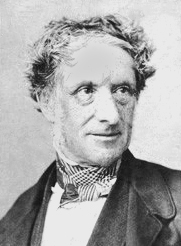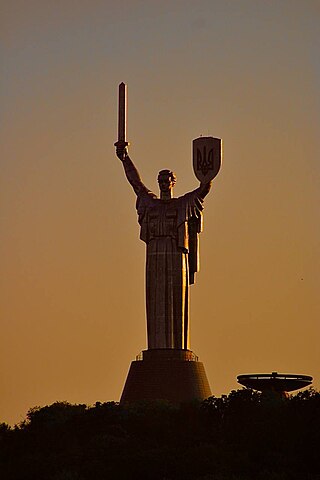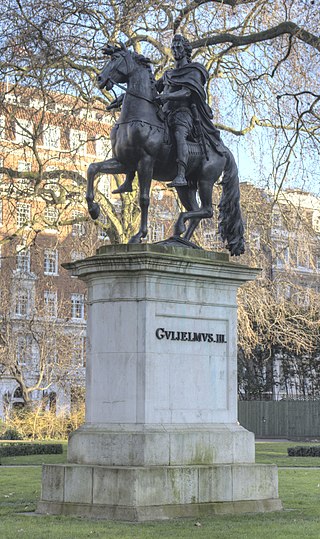
Vladimir I Sviatoslavich or Volodymyr I Sviatoslavych, given the epithet "the Great", was Prince of Novgorod from 970 and Grand Prince of Kiev from 978 until his death in 1015. The Eastern Orthodox Church canonised him as Saint Vladimir.

Sir William Hamo Thornycroft was an English sculptor, responsible for some of London's best-known statues, including the statue of Oliver Cromwell outside the Palace of Westminster. He was a keen student of classical sculpture and was one of the youngest artists to be elected to the Royal Academy, in 1882, the same year the bronze cast of Teucer was purchased for the British nation under the auspices of the Chantrey Bequest.

Sir Joseph Edgar Boehm, 1st Baronet, was an Austrian-born British medallist and sculptor, best known for the "Jubilee head" of Queen Victoria on coinage, and the statue of the Duke of Wellington at Hyde Park Corner. During his career Boehm maintained a large studio in London and produced a significant volume of public works and private commissions. A speciality of Boehm's was the portrait bust; there are many examples of these in the National Portrait Gallery. He was often commissioned by the Royal Family and members of the aristocracy to make sculptures for their parks and gardens. His works were many, and he exhibited 123 of them at the Royal Academy from 1862 to his death in 1890.

Augustus Saint-Gaudens was an Irish and American sculptor of the Beaux-Arts generation who embodied the ideals of the American Renaissance. Saint-Gaudens was born in Dublin to an Irish-French family, and raised in New York City. He traveled to Europe for further training and artistic study. After he returned to New York City, he achieved major critical success for his monuments commemorating heroes of the American Civil War, many of which still stand. Saint-Gaudens created works such as the Robert Gould Shaw Memorial on Boston Common, Abraham Lincoln: The Man, and grand equestrian monuments to Civil War generals: General John Logan Memorial in Chicago's Grant Park and William Tecumseh Sherman at the corner of New York's Central Park. In addition, he created the popular historicist representation of The Puritan.

Sir Richard Westmacott was a British sculptor.

St Volodymyr's Cathedral is a cathedral in the centre of Kyiv. It is one of the city's major landmarks and was the mother cathedral of the Ukrainian Orthodox Church – Kyiv Patriarchate before the Unification council of the Eastern Orthodox churches of Ukraine.
Events from the year 1901 in art.

Mother Ukraine is a monumental Soviet-era statue in Kyiv, the capital of Ukraine. The sculpture is a part of the National Museum of the History of Ukraine in the Second World War. In 2023, the Soviet heraldry was removed from the monument's shield and replaced with Ukraine's coat of arms, the tryzub.

Shevchenko National Prize is the highest state prize of Ukraine for works of culture and arts awarded since 1961. It is named after the inspirer of Ukrainian national revival Taras Shevchenko. It is one of the five state prizes of Ukraine that are awarded for achievements in various fields.

Monument to Prince Volodymyr, is a monument in Kyiv, dedicated to the Grand Prince of Kyiv Volodymyr the Great, built in 1853. It is located on Volodymyrska Hill, the steep right bank of the Dnipro. It is the oldest sculptural monument, a dominating feature of the Dnipro banks, and one of the city's symbols.

The equestrian statue of Ferdinand Foch stands in Lower Grosvenor Gardens, London. The sculptor was Georges Malissard and the statue is a replica of another raised in Cassel, France. Foch, appointed Supreme Commander of the Allied Forces on the Western Front in the Spring of 1918, was widely seen as the architect of Germany's ultimate defeat and surrender in November 1918. Among many other honours, he was made an honorary Field marshal in the British Army, the only French military commander to receive such a distinction. Following Foch's death in March 1929, a campaign was launched to erect a statue in London in his memory. The Foch Memorial Committee chose Malissard as the sculptor, who produced a replica of his 1928 statue of Foch at Cassel. The statue was unveiled by the Prince of Wales on 5 June 1930. Designated a Grade II listed structure in 1958, the statue's status was raised to Grade II* in 2016.

The equestrian statue of William III by John Bacon Junior stands in St James's Square in central London. It is modelled on an earlier statue of the king by John Michael Rysbrack in Queen Square, Bristol. Funding for the London statue was provided in the will of Samuel Travers, M.P., dated 1724, but nothing was done to progress the plan for a further seventy years. A design for the monument was drawn up in 1794 by Bacon's father, John Bacon Senior, but this was not executed and the commission passed to Bacon Jr., under whose direction the statue was finally erected in 1808. The statue is a Grade I listed structure.

The statue of Charles II stands in the Figure, or Middle, Court of the Royal Hospital, Chelsea, London. The sculptor was Grinling Gibbons, and the statue was executed around 1680–1682. The king founded the Royal Hospital in 1682 as a home for retired army veterans. The statue is a Grade I listed structure.

The statue of Charles James Fox stands at the north end of Bloomsbury Square in the London borough of Camden. Erected in 1816, the sculptor was Richard Westmacott. It commemorates the Whig politician who died in 1806. Fox is shown in the garb of a Roman senator. The statue is a Grade II* listed structure.

The statue of Clement Attlee on the Mile End campus of Queen Mary University of London is a bronze sculpture of the British Prime Minister, created by Frank Forster in 1988. The statue was commissioned by the Greater London Council and was intended to stand in Mile End Park. By the time of its completion in 1988, the GLC had been abolished and the statue was offered to any successor authority willing to pay the relocation costs. These were met by Tower Hamlets London Borough Council and the statue was erected outside the Limehouse Public Library to commemorate Attlee's role as the member for the Limehouse parliamentary constituency. The opening ceremony was carried out by Harold Wilson, the last living member of Attlee's 1945-51 administration. By the 21st century, the statue had been badly vandalised and was boarded up. In 2010, Tower Hamlets Council offered the statue to Queen Mary University of London on permanent loan. It was re-erected on a site at the Mile End Road campus, next to the People's Palace where Attlee had attended the vote counting in the 1945 general election and learnt of the victory which brought in his peace-time government.

The Gladstone Memorial on the Strand, London is a bronze sculpture of the British statesman, created by Hamo Thornycroft between 1899-1905. The statue was erected as the national memorial to Gladstone and shows him in the robes of the Chancellor of the Exchequer. The figure stands on a plinth surrounded by allegorical figures depicting four of the Virtues, Courage, Brotherhood, Education and Aspiration. The memorial is a Grade II listed structure.
















